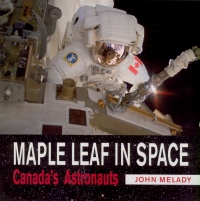| ________________
CM . . .
. Volume XVII Number 36. . . .May 20, 2011 
 |
Maple Leaf in Space: Canada’s Astronauts.
John Melady.
Toronto, ON: Dundurn Press, 2011.
157 pp., pbk., $19.99.
ISBN 978-1-55488-752-1.
Subject Headings:
Astronauts-Canada-Biography-Juvenile literature.
Outer space-Exploration-Canada-History-Juvenile literature.
Grades 5-10 / Ages 10-15.
Review by Val Ken Lem.
*** /4
|
| |
|

excerpt:
Brushing one’s teeth, using the toilet, and washing all present challenges. Often, astronauts simply swallow the toothpaste they have used, or spit it into a facecloth. There is no sink with running water to rinse one’s mouth. And showers are not really showers as we know them on Earth. In fact, they are really not showers at all. The astronauts enter an enclosed cubicle and clean up with a sponge bath. Hot water, a moist cloth, and rinseless soap are used.
Melady draws upon the three years of research that included visits to the Kennedy Space Center in Florida, the Johnson Space Center in Houston, Texas, and the Canadian Space Agency near Montreal, as well as interviews with Canadian astronauts that informed his 2009 publication for adults and senior secondary school students entitled Canadians in Space: The Forever Frontier (Dundurn Press). The current volume covers some of the same ground as his earlier title, but the focus is tailored for a younger readership, a demographic that Melady has written for before. The content and writing style are sufficiently different that schools and public libraries owning Canadians in Space should also consider acquiring Maple Leaf in Space.
Maple Leaf in Space provides a brief history of the space race and the study of space, but the focus is upon the individual stories of Canada’s astronauts. Young readers will be excited to learn about the role that animals, such as the dog Laika and Ham the chimpanzee, played in early Soviet and American space flights. Considerable attention is devoted to space travel and work conducted aboard the shuttle space vehicles, the International Space Lab, and the training that Canadian and other astronauts undergo at the Johnson Space Center. This information provides background knowledge to help appreciate the biographical accounts of each of the Canadian astronauts who have been in space, from Marc Garneau and Roberta Bondar to Robert Thirsk and Julie Payette.
Readers will be fascinated by details, such as how astronauts eat, bathe and go to the bathroom in space where microgravity makes everyday tasks very different from comparable ones on the Earth’s surface. Each of the short chapters includes one or more appropriate black and white photographs, most courtesy of NASA or the Canadian Space Agency but some by Melady himself, and one, two or three “Fascinating Fact” insets that explain topics raised in the text, such as G-force, a spacelab, the Canadarm, or introduces new information, such as an entry about the Canadian space tourist, Guy Laliberté.
The narrative becomes a bit repetitive as various launch routines are recounted. Melady manages to differentiate the astronauts’ various missions by emphasizing the varying roles that they played and describing their respective paths leading to the select profession as astronauts. They are a diverse lot. Some aspired to go into space since childhood, some pursued hobbies and careers as pilots prior to becoming astronauts, some are medical doctors while others are engineers or scientists by training. Many excelled in athletic pursuits. Good health and bilingualism in both of Canada’s official languages are two requirements to join this group. Melady emphasizes that all of these achievers worked hard in school and strove to attain their dreams. As the Space Shuttle program winds down this year, future astronauts may want to become fluent in Russian as they may be flying in a Russian Soyuz rocket and spending time, like Bob Thirsk, living in the International Space Station with Russian cosmonauts as their workmates.
The volume includes a serviceable index that should have included entries for Canada’s newest astronauts, who are identified in the epilogue, and an entry for space tourist Laliberté. Many of the 14 references listed will be readily available, and the eight websites are worth visiting.
Recommended.
Val Ken Lem is a librarian at Toronto’s Ryerson University where astronaut and engineer Julie Payette will be receiving an honorary doctor of engineering degree at the fall 2011 convocation of the Faculty of Engineering, Architecture and Science.

To comment
on this title or this review, send mail to cm@umanitoba.ca.
Copyright © the Manitoba Library Association. Reproduction for personal
use is permitted only if this copyright notice is maintained. Any
other reproduction is prohibited without permission.
NEXT REVIEW |
TABLE OF CONTENTS FOR THIS ISSUE
- May 20, 2011.
AUTHORS |
TITLES |
MEDIA REVIEWS |
PROFILES |
BACK ISSUES |
SEARCH |
CMARCHIVE |
HOME |
